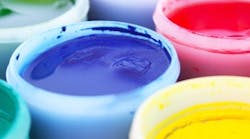Great advances have been made in the paints and coatings industry.
Once standard, lead-based paint is no longer used due to hazards it presents to human health and the environment. Volatile organic compounds (VOCs) have been found to adversely affect indoor air quality.
According to the EPA, most conventional paints and coatings contain VOCs that are off-gassed. These VOCs can be ingredients that are added to the paint to enhance product performance and shelf life or can be byproducts of the drying process. These off-gassed chemicals can cause adverse health effects, including eye, nose, and throat irritation, headaches, nausea, and even damage to internal organs.
The technology and components used in paints have evolved, reducing most of the odor problem. “Older oil-base paint technologies have a higher solvent level that can cause more odor,” explains Steve Revnew, vice president of product development for Sherwin-Williams. “As we’ve progressed as an industry and have moved to using more water-based formulas, like acrylics and latexes, there tends to be fewer odors because the primary solvent is water.”
High-quality, low-toxicity, and no- or low-VOC paint and coating products are available, but these paints and coatings may still contain or emit odorous, toxic, or otherwise undesirable compounds, such as formaldehyde and pesticides. Consider VOC content as well as overall composition and required performance characteristics, including opacity and durability, when making your selection.
Perhaps the most important component of a paint project is ventilation. No matter the type of paint you select – oil- or water-based, low- or no-VOC or standard – adequate ventilation will help mitigate the potential adverse health effects the components (and odor) can have on building occupants and workers.
“The concentration of odor is what can be harmful,” Revnew says, “which is why proper ventilation is important, whether the odor is harmful or not. Every paint formulation is different, so you should always refer to the product data sheet to understand what is potentially harmful.”
Kylie Wroblaski ([email protected]) is associate editor of BUILDINGS.
Best Practices for Painting Projects
The information in the Paints and Coatings section of the EPA’s IAQ Design Tools for Schools Recommended Action Checklists can be applied to more than just school settings. Ensure the health of building occupants by adhering to the best practices in the checklist.
- Specify the least toxic, formaldehyde-free, zero-VOC, or low-VOC paint that meets durability and other performance requirements.
- Specify products containing no lead, mercury, hexavalent chromium, or cadmium. Though regulations have nearly eliminated many toxic components from consumer paint lines, industrial and commercial paints may still contain them. Check the MSDS.
- Specify isolation requirements (isolation of construction zones from completed zones to prevent cross-contamination; removal, coverage, or isolation of porous materials to avoid adsorption and subsequent re-emission of solvents; maintaining negative ventilation in construction areas). When sanding dried paint, a dust mask should be worn.
- Review recommended duration between paint application and occupancy and review for compatibility with maintenance schedules/requirements.
- When possible, schedule work during unoccupied periods or periods of least occupancy. Large projects should be scheduled during the summer vacation months or other breaks. The maintenance schedule should also factor in manufacturer recommended air temperatures for application.
- Where possible, perform painting and stripping off-site or select materials with factory-applied finishes.
- For on-site interior painting, cover surfaces (e.g., with plastic sheeting), such as fabric-covered furnishings, that may adsorb VOCs. Specify sequence of installation so that painting and other "wet" applications occur before installation of "fleecy" materials.
- Consider constructing barriers (for example, walls or curtains of plastic sheeting) to help isolate portions of larger areas and minimize the distribution of dust and other pollutants.
- Wipe down all surfaces with a wet cloth as soon as practical after completing all dust-generating work typically associated with surface preparation.
- Carefully observe manufacturer’s recommendation for cleanup, storage, and disposal of paints, primers, and thinners. (Note: Some products are classified as "flammable liquids" under federal regulations and must be stored in a specifically constructed safety cabinet.)
- Keep paint containers covered as much as possible during and following use to protect against VOC release.


